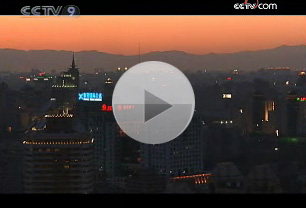Source: CCTV.com
09-24-2008 14:14
According to the weather forecast, Typhoon Matsa would arrive over Beijing in the evening of August the 6th, 2005. That night, everyone was hurrying home to escape the storm. However, it was a crucial night for the co-operative housing team. They were to hold a shareholders’ meeting to vote on an important project.
 |
| Watch Video >> |
29 people were supposed to attend the meeting. In the event, only 16 showed up.
 |
The people coming to the meeting were all shareholder representatives of the co-operative housing group. They were due to vote on whether they should submit their offer to buy land at Shaoyao Ju to an auction three days later. However, with half of the people absent, the team leader Yu Linggang suspended the vote. In his opinion, the purpose of the meeting was not only to vote on the auction, but also to determine the future development of the group. Because of this, it was the most important meeting since he established his co-operative housing scheme.
At the end of 2004, Yu Linggang, a computer maintenance engineer, had launched a co-operative housing scheme. He hoped to gather 200 to 300 people to jointly construct a building. It was a way of allowing people to become property developers, buy a satisfactory home at cost price, and enjoy management autonomy.
His proposal soon attracted enormous media interest. His scheme was described as eliminating the real estate developers. More than 600 people joined Yu Linggang in the following two months. They established a co-operative housing alliance. Three hundred of the members invested a total of 110,000 yuan and founded the Lancheng Company as the executive body of the alliance. Shareholder representatives and directors were elected, and Yu Linggang was chosen as the chairman of the board of directors.
Three months after the Lancheng Company was founded, a public auction was due to be held, for a plot of land at Shaoyao Ju, on the North 4th Ring Road in Beijing.
Yu Linggang was convinced that Shaoyao Ju was the ideal choice for his co-operative housing project. So he decided to recommend to his group that they compete with real estate developers, to buy the land.
Winning the auction would require a huge sum of money. The Lancheng Company, as a non-profit agency, had to gather together enough people to raise the capital.
The estimated cost of the land at Shaoyao Ju was 100 million yuan. Just taking part in the auction would require the payment of a 10-million-yuan deposit. The group held a land selection meeting at the end of July, to confirm the source of the capital. It was decided that 40 million yuan would come from the participants, and over 50 million yuan from a loan.
The meeting set a series of goals. The first was to collect 40 million yuan before August the 8th, 2005. The project was divided into 340 units, each of which could be secured with a 150,000 yuan deposit from a group member. To stand a chance of winning the auction for the land at Shaoyao Ju, the group needed to attract more than 200 participants within 9 days.
Within seven days of the land selection meeting, the team had collected 38 million yuan. This was just 2 million yuan less than what was needed. But with only 2 days to go before the deadline, many of the shareholder representatives believed no one else would come forward to cover the 2-million-yuan shortfall. Typhoon Matsa didn’t visit Beijing on the night of August the 6th, as expected. At the meeting place, having waited a long time, Yu Linggang decided to ask the 16 shareholder representatives to veto the Shaoyao Ju project.
So, even though Shaoyao Ju was clearly the best location for their co-operative housing project, they decided not to move forward.
Many of the shareholder representatives had already foreseen the failure of the project. Even before the land selection meeting, many participants had voiced concerns about the high cost of the housing. The budget was 7,000 yuan a square metre, which was already 1,000 yuan more than the original target price.
The group decided not to sell the ground floor as commercial premises. This effectively increased the price of the housing by 1,500 yuan a square metre. Instead they would lease the ground floor, and this could bring in up to 2,000 yuan per square meter every year. Even so, there was no certainty that they would make any profit. So a lot of people declined to sign the contract.
The high price of the housing clearly influenced some people’s decisions. Public doubts also undermined people’s confidence in the Shaoyao Ju project. When Yu Linggang launched the co-operative housing scheme, he had declared that it was a way of eliminating real estate developers. However, within only six months, he had decided to cooperate with a Real Estate Company called Wantong, which would provide a 50 million yuan loan for the Shaoyao Ju project. This ran counter to the basic principle of co-operative housing, and the media and public began casting doubts on Yu Linggang’s plans.
To protect its capital, Wantong Real Estate had increased the interest rate on the loan from its normal 8%, to 15%. In addition, there was a boiler room on the Shaoyao Ju site, which would have to be removed. These factors would further push up the housing price and consequently reduce the number of participants. With all these issues, the co-operative housing scheme attracted fewer than 200 people. The Shaoyao Ju project, which the group had spent two months preparing for, had failed.
